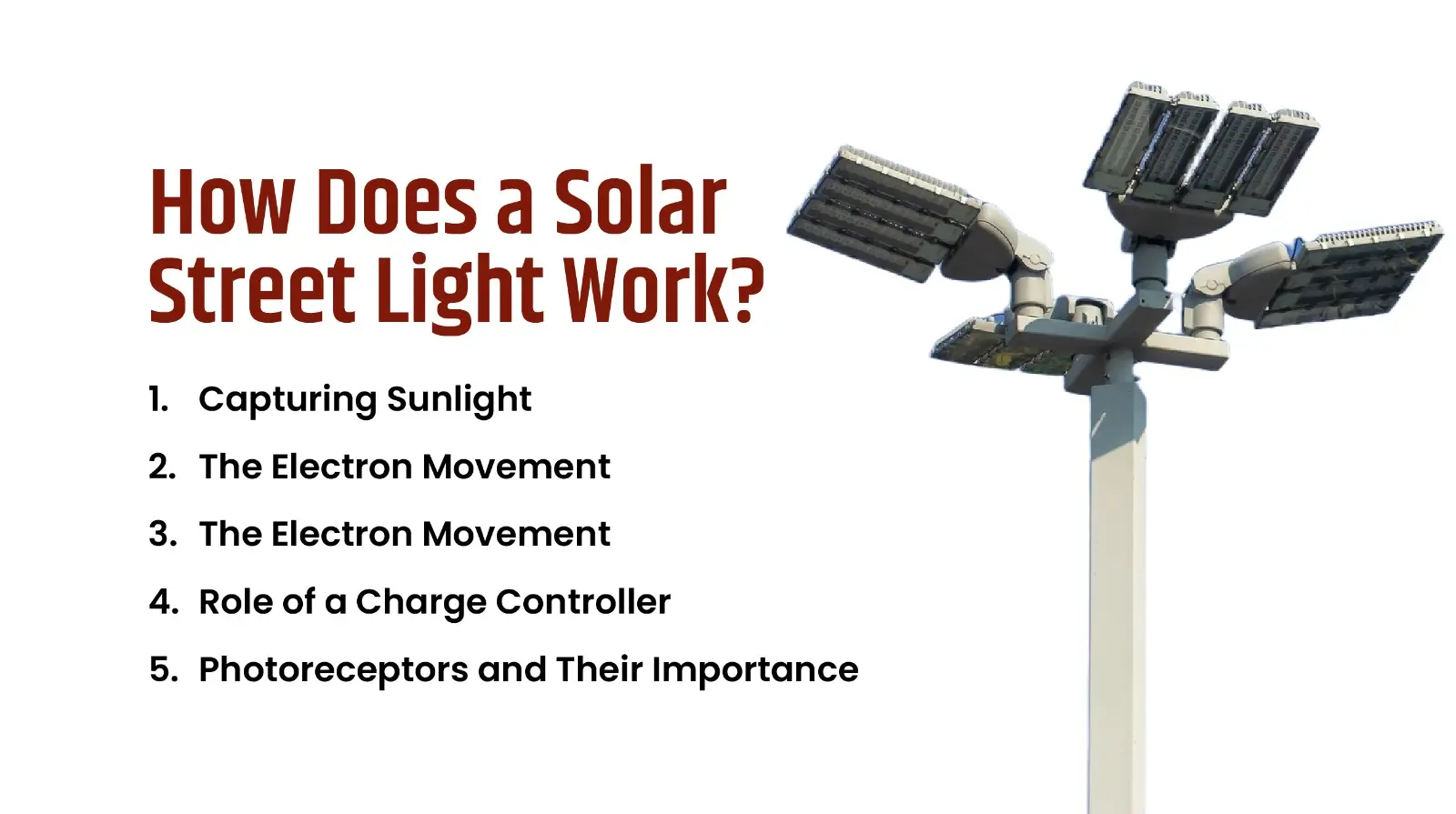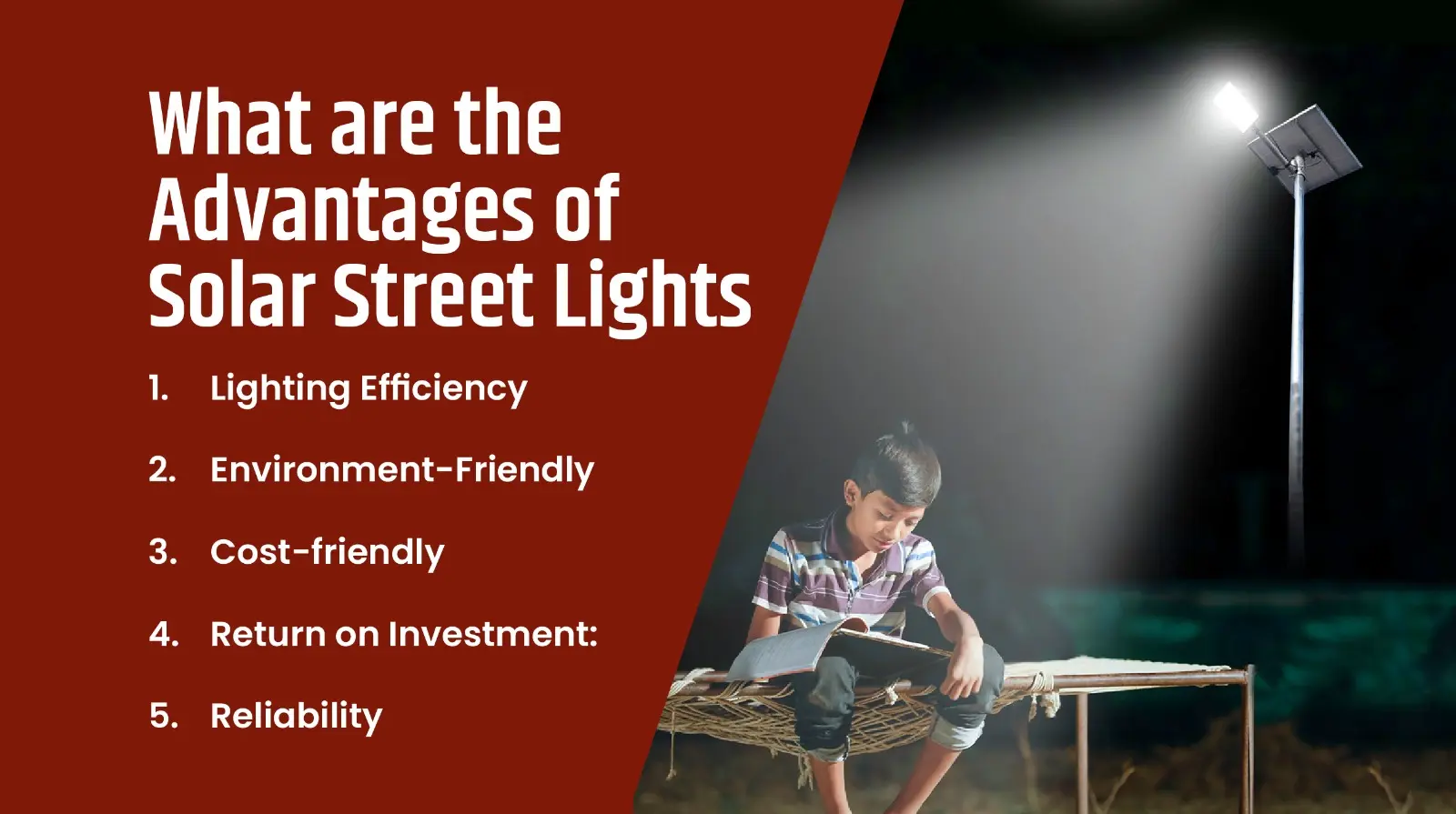What is a Solar Street Light?
Street lights are essential for safety purposes, and one can witness the growing popularity of them. A solar street light takes this one step further with its reliance on solar panels for power rather than the regular grid electricity. The advancing technology has offered solar street lights as a sustainable, long-term solution.
Solar street lights are different from traditional ones, offering many advantages. Thanks to the photovoltaic panels, which generate clean electricity, making these street lights efficient. In this blog, we’ll learn more about these wonderful solar street lights!
Components of a Solar Street Light
Component |
Description |
|
Solar Panel |
Converts sunlight into electricity. |
|
Battery |
Stores energy from the solar panels. |
|
LED Lamp |
Provides illumination with low energy consumption. |
|
Charge Controller |
Manages energy flow between the panels, battery, and light. |
|
Pole |
Supports the solar panel and light fixture. |
|
Lamp Post |
Protects the light fixture. |
|
Light Sensor |
Automatically turns the light on at dusk and off at dawn. |
|
Inverter |
Converts DC to AC for certain systems. |
How Does a Solar Street Light Work?

You can easily understand the working of the solar street light by following a step-by-step approach. Understand with us in easy steps how these outdoor solar lighting systems operate.
Step 1: Capturing Sunlight
Photovoltaic panels are installed near or above the poles of these solar street lights. These panels collect the photons of the sunlight to make electricity out of it.
Step 2: The Electron Movement
When the rays of the sun meet with solar cells made of a semiconductor, the activated electrons start their to-and-fro movement. This flow contributes towards the generation of direct current electricity in the circuit.
Step 3: Storage in a Rechargeable Battery
Since these solar lights use the sun’s energy to generate electricity, it's to be used instantly. But what happens when there's no use for the electricity? For such times, batteries allow for the usage of electricity when the sun doesn't shine. These batteries are charged with electricity.
Step 4: Role of a Charge Controller
Controllers act as intermediaries between the batteries and panels. They safeguard the battery life of the street lights by voltage regulation. They manage the amount of voltage and current coming from the panels.
Step 5: Photoreceptors and Their Importance
The street lights know when to turn on and off without manual assistance. How? Well, the photoreceptors or light sensors detect the lack of sunlight and wave a green flag to energy movement from batteries to LED bulbs. The reverse of this happens at every daybreak.
What are the Advantages of Solar Street Lights

- Lighting Efficiency: We have just read that solar street lights use LED lights in most cases. They are used extensively because of their brighter and more energy-saving nature. Hence, making the solar lighting system more effective.
- Environment-Friendly: Our ultimate source of energy here is the sun. Needless to say, this sort of energy is less harmful to the environment and at the same time, renewable too. Large-scale use of solar street lamps negatively impacts our dependency on fossil fuels, which is a good thing!
- Cost-friendly: We can all agree upon the need for cost-friendly options for large-scale projects. Apart from the installation costs, the operation of these solar lamps requires minimal spending. Since they are self-sufficient in producing their energy, they only need proper maintenance at times.
- Return on Investment: The return is very positive in the case of solar street lights. They last for many years and function properly. Innovations make for excellent weather protection, further increasing their lives.
- Reliability: Solar options in general ensure freedom from the grid and its complications. So, our solar street lights are very reliable in situations of power cuts or faults. They will shine regardless and provide help at night.
- Accessibility: This is also directly linked to their independent nature. We cannot deny how important Solar lighting systems are. In areas where there is no grid power supply, we can install them instead. The comfort of light can reach even the remotest of places.
- Safety and Security: With remarkable efficiency and reliability, solar street lights are the king of all choices in this area. They will aid by increasing visibility, allowing access to travel and also reducing instances of crime. Well-lit communities and roads are indeed preferable to all of us!
Read more here: Advantages and Disadvantages of Solar Street Lights.
Applications of a Solar Street Light
- Residential Areas: Enhances safety and visibility, reducing crime and accidents at minimal cost.
- Parks & Public Spaces: Provides eco-friendly, reliable lighting for safe recreational areas.
- Parking Lots: Illuminates dark parking areas, ensuring security for workers and customers.
- Roads & Highways: Improves road safety with constant lighting, even during power outages or bad weather.
- Remote & Rural Areas: Offers a cost-effective and reliable lighting solution where traditional electricity is unavailable.
- Emergency Lighting: Acts as a backup during power disruptions, aiding rescue operations and ensuring safety.
Installation Process of Solar Street Lights
The installation process for solar street lights is really interesting and easy to grasp. Let's look at it in detail below.
1. Prparing the Pre-requisites
Before we even begin with the panels and batteries, prior work needs to be done. This will include selecting a suitable location for placing the poles. It's followed by preparations for installing and fixing poles at all designated places.
2. Pre-assembly Work
Now is the time to bring all our components before setting up the system. Check whether all the parts are functioning properly or not, so that later malfunctions can be avoided.
3. Battery and Panels Installation
The next important step will, of course, be to add a battery and solar panels. Install panels in a manner that maximizes their exposure to sunlight for more energy generation. Connect batteries to the system to store all the daytime production of energy. At night, this battery supplies it back to the light sources.
4. Wiring and Lighting
This step deals with cabling and wiring work to secure connections. Before the poles are fixed, light sources like LED lamps are also connected to them.
5. Controllers and Sensors
This step involves the addition of controllers to the circuit with proper wiring to manage the flow of power. The installation of light sensors eliminates the manual task of switching the solar street light on and off. These sensors help in timely operation while minimizing the wastage of electricity.
6. Testing and Adjustments
After setting up the whole structure, it's very important to test the working of the whole system. And you should resolve any faults immediately before they are put to official use.
Cost of Solar Street Light Installation
The cost of the first investment regarding solar on-grid & off-grid solutions varies. Solar street light price is subject to many factors which determine it. A typical price for a solar street light ranges from ₹10,000 to ₹22,000 per unit.
- Wattage: High-wattage lights will cover more area, requiring less number of poles. This will also increase the price.
- Battery type: We all know that large batteries are better. Indeed, more battery power ensures proper hours of service. The choice of battery will affect the solar street light price, as it determines solar energy storage capacity.
- Solar Panel type: Solar panels come in all varieties. Monocrystalline panels, for example, will cost more than polycrystalline panels. However, we advise you to keep quality over cost as the deciding factor, because a good solar panel becomes very important in the long run.
- Sensors and other additions: Additional features like photoreceptors or motion sensing will bring in more expenses, but also provide way better services.
Cost Breakdown of Solar Street Lights
We all look for a middle ground between cost and quality. We will advise you to go ahead with the most suitable options because this outdoor solar lighting will save you money in the long term. Below is an estimate of the costs you may have to spend for different choices:
- Basic solar street lights – A very simple structure would cost around ₹2000 to ₹4000 on your part.
- Mid-range solar lighting – Better light sources and battery power will generate a bill of about ₹4000 to ₹12,000.
- Advanced solar street lights – With amazing features and good efficiency, they will cost about ₹10,000 to ₹22,000.
Government Subsidies for a Solar Street Light Installation in India
You might already be aware of the Government subsidies in the area of solar energy. Since solar energy is an important investment, the government has sought to motivate us all through various schemes. This will help us all contribute towards the betterment of the environment.
The government has taken several initiatives, such as Atal Jan Jyoti Yojana (AJAY). They provide necessary central financial assistance (CFA).
National level initiatives:
1. Atal Jyoti Yojana
This interesting scheme aims to provide solar street lighting systems in rural and urban areas with less than 50% grid connectivity. Under two phases, 1.35 lakh and 1.37 lakh solar street lights have been installed all over the country.
75 percent of the cost was borne by MNRE, while the remaining was covered by MPLADS (Member of Parliament Local Area Development Funds).
2. Street Lighting National Programme (SLNP)
This was a government initiative to replace large-scale street lights with solar ones. Before it, only grid solutions were used. This was important for transformation in public areas and highways at large.
State-level initiatives:
1. Mukhyamantri Gramin Solar Street Light Scheme
This initiative of the Bihar Government has promised to install solar street lights in rural areas. Despite some delays, the project is expected to help very much towards limiting pollution.
2. SPV Street Lighting Scheme for Rural Area
This task taken by Haryana's government is appreciable. From our experiences, we know the difficulties related to lighting in rural areas. A subsidy of ₹4000 is provided with a solar street lighting system under this. Similarly, a sum of ₹20,000 is given per unit for a solar high mast lighting system.
The governments at the state level provide many such helpful and encouraging incentives.
Conclusion
Can we all agree that solar street lights are, hands down, one of the best things to exist? Partnering with LED lights and large batteries, they are such a strong team against darkness.
Don't feel confused about how to invest in this field. KLK Ventures will be your torchlight if you decide to adopt this solar energy and help the world move into a brighter future!
